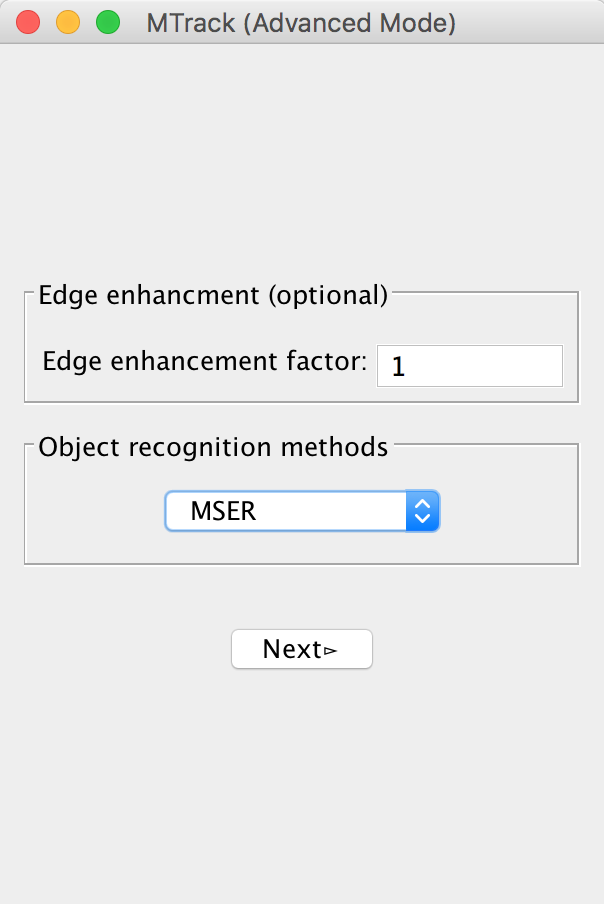Advanced mode(MTrack)
Contents
Object recognition methods
In advanced mode there are three distinct methods to identify microtubules, MSER, Watershedding followed by Hough Transform and MSER followed by Hough Transform. The object recognition for microtubules is performed on a preprocessed image, on that preprocessed image a Canny edge detector followed by a mean filter with a radius determined by the PSF of the microscope is applied, in the simple mode the edge enhancement factor is simply 1. In this mode this is adjustable, increasing this parameter causes the microtubules to appear thicker on the preprocessed image. This factor can be increased if certain microtubules are not properly detected by the Object recognition method of choice.
MSER
This is the default method of object recognition in the simple mode and for sparsely populated images is the method of choice to find the regions in the image where the microtubules lie, the microtubules are assumed to lie along the semi-major axis of the MSER ellipses. Read more about MSER parameters.
Watershedding and Hough Transform
For crowded movies MSER based segmentation may not be able to separate close lying seeds. To do that watershed based segmentation may be needed, watershedding is able to demarcate the regions where each microtubule lies. After these regions have been found a Hough Transform is performed to obtain the line parameters for each microtubule. Read more about watershedding and Hough transform parameters.
MSER and Hough Transform
For not so dense images the microtubules are easy to locate and MSER is able to do so, in the default MSER approach it is assumed that the microtubules lie along the semi-major axis of the microtubules, which is true in most of the cases. If however they do not lie along the semi-major axis of the ellipses a Hough transform inside each of the ellipse can be performed to determine the line parameters for each seed.
In this approach the user has to first make a selection of the MSER parameters and then Hough transform parameters (see MSER parameters and Size of Hough space in rho/theta in watershedding and Hough transform parameters), MSER ellipses would be displayed in which the Hough transform would be carried out to find the line parameters of all the microtubules.
The first panel for this mode is shown below.
The next button appears on this panel only after the user has made the choice of the object recognition method.
Tracking options
After clicking the next button the user has several options to choose from before starting the tracking.
- Deselect and select ends
Before starting the actual tracking of the dynamically growing microtubules, the program will give you several options. Before choosing endpoints to remove or add you check all frames of the movie by moving the slider in the “Deselect and select ends” dialog. Select or deselect ends. If an end was wrongly recognized or two points are too close to each other you can deselect an end by left clicking on it in the image (will appear as pink circle instead of green). The program will remember and allow to re-select this end by clicking left click again near to the end point of interest (the pink circle becomes green again). In case an end has not been recognized or a randomly nucleated end has to be selected, use Shift + left click to select a user defined end (orange circle will mark the end). Making a left click near the user defined seed end deselects it and marks it as red, the user can make as many clicks to select the ends they want to. Read more on microtubule polarity and (+) end vs. (-) end tracking.
- Select time
The tracking is performed from the first frame till the end frame by default, if the user however wishes to alter the start and the end frame of tracking they can do so here. The tracking will then be performed from the user chosen start frame till the user chosen end frame.
- Select Segmentation method
For the dynamic channel the user here has the option of selecting just MSER as the segmentation method or watershed followed by MSER, the first method is the default method in the simple mode. The second method is provided here to ensure correct assignment of the end points over the time frames when microtubules get too close to each other and collide for example. The parameter selection required for each of the two segmentation methods is made in the next panel to which the user can flip to after making this choice.
After choosing appropriate parameters in either of the two segmentation methods the user can then track and save the program parameters for a batch mode run.


